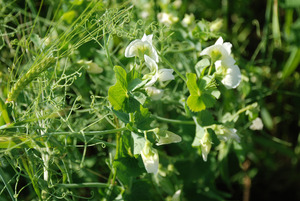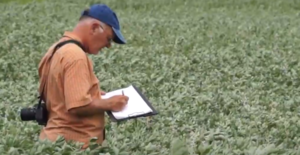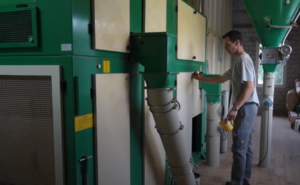Increasing domestic protein supply with intercropping - a success story from Switzerland
In 2008, Bio Suisse and FiBL established a cross-sectoral working group with the aim to increase domestic production of high-protein feed and decreasing the need for imports. The most important question was how it was agronomically possible to promote domestic grain legumes.



Problem encountered
Over ten years ago, organic peas and fava beans were cultivated on only about 80 hectares in Switzerland, accounting for a mere 3 % of Swiss demand for organic feed. Domestic grain legume cultivation remained a disfavoured crop because pure stands often begin lodging before they are harvested, increasing the risk of late weed infestation, decreasing yield and complicating the threshing process. On the demand side, grain legumes, both peas and field beans, are highly valued in pig and cattle feed. The demand of organic protein raised during this same period due to a higher demand of organic egg and pork production. There was, and still remains, a great shortage of organic protein-rich feed in Switzerland. This discrepancy between supply and demand was met by large quantities of imported organic feed, often soy from China.
Solutions implemented
FiBL and farmers conducted trials to optimize intercropping suitable mixtures, testing different varieties, mixing ratios, sowing and harvesting techniques and maintenance measures. The two involved feed companies – Rytz and Lehmann – developed a process for separating the grains and grain legumes, and guaranteed sales. Crop mixtures which worked very well in the past, like peas/barley, field beans/oats, summer peas/triticale were used. Intercropping presents very good crop and cultivation techniques for the farmers to mitigate lodging, as the cereals supports the grain legume crop, resulting in fewer losses during harvest.
Challenges encountered
Pricing plays a decisive role in incentivising domestic production of fodder crops and intercropping practices. Mitigating challenges generated from agricultural subsidies were considered decisive. From the production side, in the bean/oat mixture sometimes the hectolitre weight of oat is too low. This necessitates more thorough cleaning of the mixture. Additionally, optimizing relationships between the partner plants, decreasing lodging and facilitating synchronous maturation of grains for the harvest presented a challenge. The last big challenge was developing appropriate harvesting and milling techniques for intercropped grains.
Why was it successful?
The decisive factor of success was the inclusion of actors along the entire value chain. Four actors were responsible for one success factor each:
- FiBL has developed more stable cultivation systems together with organic farmers. By growing peas in mixed cultivation, peas have been able to establish themselves in crop rotations. Scientific work was done by the advisors with on-farm research focussing on optimizing cultivation techniques.
- Bio Suisse increased the price by 10 francs per decitonne and siphoned off subsidies from imported grain and transferred them to grain legumes.
- As a result of the groups lobbying, the Swiss government adapted the Direct Payments Ordinance so that intercrops receive the full grain legume contribution, provided they contain at least 30% grain legumes.
- The millers improved the separation technique and the cleaning process. They also guaranteed that they would accept the resulting harvest of mixed crops.
Today, approximately 1000 hectares of peas and field beans are cultivated with about 20-collection points across Switzerland. That is an increase from 3 to 15 % of protein self-sufficiency in Switzerland since 2008. The aim of the project is to raise domestic protein production to 20 % by 2021. The project hopes to continue developing new intercropping systems for grain legumes and evaluate different varieties, combination, sowing, harvest and sorting machineries for suitability in organic production. This example shows that it is not enough to improve cultivation techniques alone, project framework conditions must be designed so that producer prices are fair and sales are guaranteed.
 tap and then scroll down to the Add to Home Screen command.
tap and then scroll down to the Add to Home Screen command.